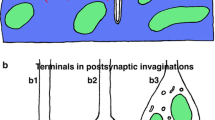Summary
The buccal mass retractor muscles of Philine aperta are unusual in possessing a system of transverse tubules in what are in other respects typical unstriated muscle fibres. The tubules are formed from invaginations of the sarcolemma that penetrate up to 9 μm radially into the fibre. There is some indication that the tubules are zoned at certain points along the fibre. Physiologically, the outer membrane of the muscle fibre does not support an action potential, and the fibre contracts by summation of small twitches in response to individual excitatory junction potentials. Neuromuscular junctions occur in shallow grooves along the surface of the fibres. They contain 3 types of vesicles; clear, intermediate and dense-cored. A scheme suggesting how striated muscle may be derived from the unstriated condition is described.
Similar content being viewed by others
References
Barrantes FJ (1970) The neuromuscular junctions of a pulmonate mollusc. I. Ultrastructural study. Z Zellforsch 104:205–212
Brace RC (1977) The functional anatomy of the mantle complex and columellar muscle of tectibranch molluscs (Gastropoda: Opisthobranchia), and its bearing on the evolution of opistobranch organisation. Phil Trans R Soc Ser B 277:1–56
Gerschenfeld HM (1963) Observations on the ultrastructure of synapses in some pulmonate molluscs. Z Zellforsch 60:258–275
Heyer CB, Kater SB, Karlsson UL (1973) Neuromuscular systems in molluscs. Am Zool 13:247–270
Josephson RK (1975) Extensive and intensive factors determining the performance of striated muscle. J Exp Zool 194:135–154
Karnovsky MJ, Roots L (1964) A “direct colouring” thiocholine method for cholinesterases. J Histochem Cytochem 12:219–221
Kobayashi M (1972) Electrical and mechanical activities in the radula protractor of a mollusc, Rapana thomasiana. J Comp Physiol 78:1–10
Lewis PR, Shute CCD (1966) The distribution of cholinesterase in cholinergic neurons demonstrated ith the electron microscope. J Cell Sci 1:381–390
Orkand PM, Orkand RK (1975) Neuromuscular junctions in the buccal mass of Aplysia: Fine structure and electrophysiology of excitatory transmission. J Neurophysiol 6:531–548
Palay SL (1956) Synapses in the central nervous system. J Biophys Biochem Cytol 2:193–201
Peachy LD (1965) The sarcoplasmic reticulum and transverse tubules of the frog's sartorius. J Cell Biol 25:209–231
Peachy LD, Adrian RH (1973) Electrical properties of the transverse tubular system. In: Bourne GH (ed) The structure and function of muscle, vol III. Academic Press, New York London
Plesch B (1977) An ultrastructural study of the musculature of the pond snail Lymnaea stagnalis (L.). Cell Tissue Res 180:317–340
Prescott L, Brightman MW (1976) The sarcolemma of Aplysia smooth muscle in freeze-fracture preparations. Tissue and Cell 8:241–258
Reynolds ES (1963) The use of lead citrate at high pH as an electron-opaque stain in electron microscopy. J Cell Biol 17:208–212
Richardot M, Wautier J (1971) Une structure intermédiaire entre muscle lisse et muscle strié. La fibre musculaire du bulbe buccal de Ferrissia wautieri (Moll. Basomm. Ancylidae). Z Zellforsch 115:100–109
Rogers DC (1968) Fine structure of smooth muscle and neuromuscular junctions in the optic tentacles of Helix aspersa and Limax flavus. Z Zellforsch 89:80–94
Rogers DC (1969) Fine structure of smooth muscle and neuromuscular junctions in the foot of Helix aspersa. Z Zellforsch 99:315–335
Sanger JW (1971) Sarcoplasmic reticulum in the cross-striated adductor muscle of the bay scallop, Aequipecten irridians. Z Zellforsch 118:156–161
Sanger JW, Hill RB (1972) Ultrastructure of the radula protractor of Busycon canaliculatum, sarcolemmic tubules and sarcoplasmic reticulum. Z Zellforsch 127:314–322
Watson SJ, Barchas JO (1977) Catecholamine histofluorescence using cryostat sectioning and glyoxylic acid in unperfused frozen brain: a detailed description of the technique. Histochem J 9:183–195
Author information
Authors and Affiliations
Additional information
The authors would like to thank Dr. N. Runham for commenting on the original manuscript
Rights and permissions
About this article
Cite this article
Dorsett, D., Roberts, J.B. A transverse tubular system and neuromuscular junctions in a molluscan unstriated muscle. Cell Tissue Res. 206, 251–260 (1980). https://doi.org/10.1007/BF00232769
Accepted:
Issue Date:
DOI: https://doi.org/10.1007/BF00232769




